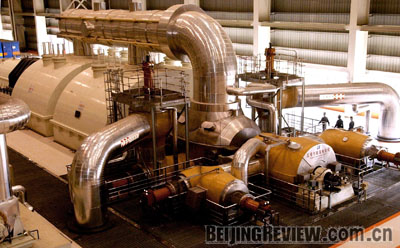|

CATCH-22: China’s coal-fueled power generators must pay more for free-market coal,
but the government’s price freeze on electricity prevents them from recouping the cost
"China now relies on railways for more than half of its coal transport from the west to the east, but the railway transport network has approached its capacity and ended up causing disruptions in coal supplies," Dong wrote in the report.
China's railway coal transportation volume only rose a moderate yearly 7.1 percent in 2007, lagging behind the double-digit growth of coal output in the same year, according to the NBS.
On top of these factors came the country's worst snowstorm in 50 years, which battered central and south China in late January and early February. The storm at one time almost crippled the country's already challenged logistics systems for getting coal to power plants. Snow drifts hampered the railway transport of coal, and trucks were also stranded on ice-covered roads.
All these factors have driven up thermal coal prices. According to the NBS, the average price for a ton of thermal coal was 509.2 yuan ($74.50) in May, or 23 percent higher than in January, the country's coldest month of the year.
Since 2006, the Chinese Government has deregulated the price of thermal coal to float in line with market demand free of government controls. Although the average price lingered well short of the market price in the past, it immediately rose on par with the market price after the policy went into effect.
But at the same time, the coal-fueled generators have been reluctant to pay higher prices for free-market coal, because power prices-still under the firm grip of the government-have been mostly static.
According to government stipulations, electricity prices are allowed to rise if the price of thermal coal rises by more than 5 percent within a period of six months. This situation, called the "coal and electricity price linkage mechanism" by industry insiders, only occurred twice in China in 2005 and 2006.
Last year, as thermal coal prices surged, power producers petitioned the government once again for price increases. But the government, out of fear of further fueling the already simmering inflationary concerns, ordered a price freeze on essential household items, including electricity.
Forced to absorb the higher costs, large power generators have seen their profit margins drop. Smaller power plants, under heavy cost pressure that has yet to be passed on to consumers, are shutting down. According to the NDRC, the three largest state-owned generators-China Power Investment Corp., China Huadian Corp. and China Guodian Corp.-reported losses of more than 400 million yuan ($58.5 million) each in the first quarter of this year.
| 